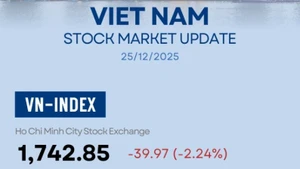China, the US, the Republic of Korea, and Japan are the leading markets for importing Viet Nam’s fruits and vegetables. These are also “fertile lands” with ample potential for export acceleration in the final months of the year.
Growth drivers
According to Nguyen Thanh Binh, Chairman of the Viet Nam Fruits and Vegetables Association (Vina Fruit), in recent times, Vina Fruit’s member enterprises have stepped up the application of high technology in production; complied with regulations on traceability, planting area codes, and packing house codes; and met food safety standards in import markets, thereby expanding exports of vegetables and fruits to many countries. Among these, durian is the main export item and has recorded a sharp increase in value in the third quarter of 2025, reaching 1.94 billion USD, up 30.3% year on year.
In the first nine months of 2025, although the export value of Viet Nam’s durian fell by 1.7% year on year, it still reached 2.76 billion USD overall. Other items such as dragon fruit, banana, mango, jackfruit, and coconut all saw strong growth in export value. Notably, the export value of lychee in the third quarter of 2025 rose very strongly compared with the same period last year, bringing total exports in the first nine months to 73 million USD, up 312.1% year on year.
A notable highlight of fruit and vegetable exports in the third quarter of 2025 is that the export value of processed fruit and vegetable products accounted for 16.6% of the total export value of fruits and vegetables, reaching 507 million USD, up 47.4% compared with the third quarter of 2024. The largest destinations for processed products were China, the US, the Republic of Korea, the Netherlands, and Japan.
In the first nine months of 2025, although the export value of Viet Nam’s durian fell by 1.7% year on year, it still reached 2.76 billion USD overall. Other items such as dragon fruit, banana, mango, jackfruit, and coconut all saw strong growth in export value. Notably, the export value of lychee in the third quarter of 2025 rose very strongly compared with the same period last year, bringing total exports in the first nine months to 73 million USD, up 312.1% year on year.
It is forecast that from now until the end of the year, key items such as durian, dragon fruit, and pomelo will grow rapidly to serve festive-season and Lunar New Year demand in many countries. Enterprises are currently preparing high-quality supplies and proactively planning transport options to access markets in the most favourable way.
For the key product of durian, according to the Plant Production and Protection Department (Ministry of Agriculture and Environment), Viet Nam currently has 24 laboratories accredited by China’s General Administration of Customs, with a total theoretical capacity of about 3,200 samples per day, sufficient to meet actual needs. Regarding customs clearance, at major border gates, durian exports to China continue to proceed smoothly.
Entering the final months of the year, Vietnamese pomelo has also received good news as it became the sixth Vietnamese fruit to gain market access to Australia, with dragon fruit, lychee, longan, mango, and passion fruit having previously been cleared for export to this market. Nguyen Phong Phu, Technical Director of Vina T&T Group, shared that partners in Australia are currently very interested in Vietnamese pomelo and have been placing continuous orders. The growth opportunity for this fruit in Australia is very high because it does not face significant competition from similar products of other countries.
Moreover, Vietnamese pomelo is also applying standard cultivation processes, pest control, and traceability, fully meeting the technical requirements of many markets around the world. It is also among the top 10 Vietnamese fruit export items by value at present.
Focus on major markets
To reach the 8 billion USD mark early, in the final months of the year, enterprises need to focus on boosting fruit and vegetable exports to major markets such as China, the US, Japan, and Germany. According to China’s customs authority, the value of fruit and vegetable imports into China in the first nine months of this year reached 20.3 billion USD, up 5.8% compared with the same period in 2024. Of this, imports from Viet Nam accounted for 20% of total imports, up from 17.9% in the same period last year.
Dang Phuc Nguyen, Secretary-General of the Viet Nam Fruits and Vegetables Association, believes that, thanks to geographical proximity and fast delivery times, Vietnamese fruits and vegetables have strong competitiveness in freshness and quality compared with many other countries in the Chinese market. However, to expand market share, Vietnamese enterprises need to strictly meet China’s standards on quarantine, traceability, and packaging; and promptly update changes and adjustments to regulations and standards for exporting agricultural products to this market.
According to Ngo Xuan Nam, Deputy Director of the Viet Nam Sanitary and Phytosanitary Notification Authority and Enquiry Point, China has recently announced Order 280 to replace Order 248 on the management of registration for foreign food manufacturers exporting to China, effective from June 1, 2026. Therefore, enterprises need to review documentation, prepare data, and adjust registration and export procedures to comply with the new requirements.
Thanks to geographical proximity and fast delivery times, Vietnamese fruits and vegetables have strong competitiveness in freshness and quality compared with many other countries in the Chinese market.
Dang Phuc Nguyen, Secretary-General of the Viet Nam Fruits and Vegetables Association
The US is a potential market with considerable room for growth for Vietnamese fruit and vegetables. A major challenge is high logistics costs, which make many items, especially fresh fruit, less competitive than those from countries such as Mexico, Canada, Chile, and Peru. Therefore, the strategy to increase turnover in the US is to focus on deeply processed vegetables and fruit with a long shelf life and easy transport; this also aligns with US consumers’ shift towards convenient products that still ensure quality and nutrition.
















